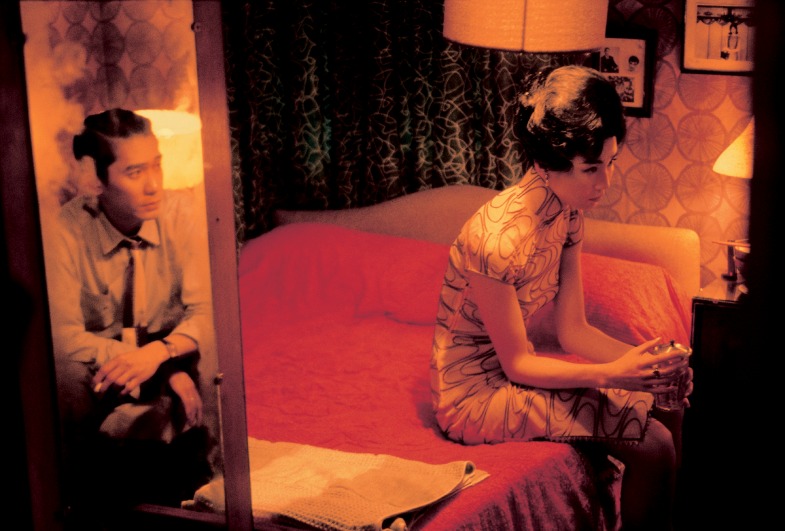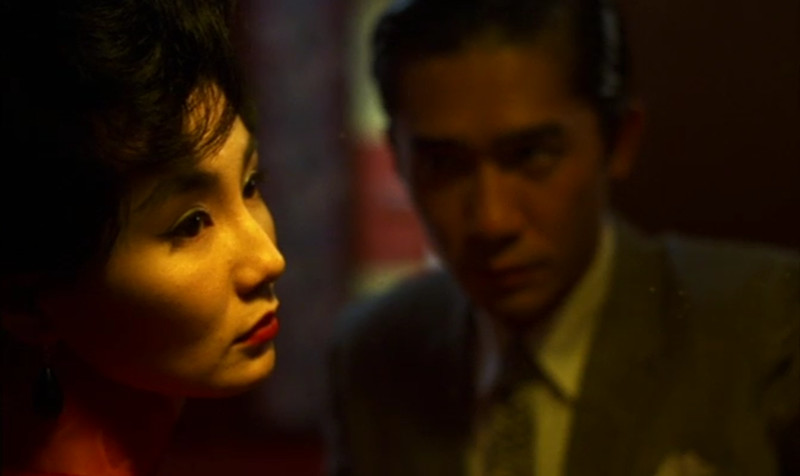5. Subtle eroticism

In “In the Mood for Love”, eroticism is shown without nudity or sex scenes, in a subtle manner. For example, this is shown in the way Mrs. Chan walks and how the camera slowly moves first showing her legs, then the upper part of the body. The music and intense colours add up to the eroticism presented in the film. The way Mrs. Chan flirts with Mr. Chow in one scene, touching him with her finger, is another example.
Some may find the movie cold, and when compared to Western romantic movies, it may be true. Nevertheless, in the most important scenes in the film, there is a certain warmness and intimacy, especially when Mr. Chow and Mrs. Chan take each other’s hand, which is filmed with a extreme close-up. Medium shots and close-ups prevail in the movie creating an intimate mood.
This eroticism, concerning the nature of the movie and the protagonists’ relationship, is often sad, and it is a longing that is never fully satisfied.
6. Blurring the lines between “reality” and illusion

The aforementioned scene in which Mr. Chow and Mrs. Chan both make the first move suggests that one of them is illusory and the other actually happened. Who made the first move is irrelevant, as they both wanted it. Nevertheless, Wong Kar-wai toys with the idea of alternate realities to highlight the idea that romantic feelings just happen in accord with their nature.
Regardless of whether one or the other first made an advance, the result is the same. Later in the film, they rehearse Mrs. Chan asking her husband if he has a lover. Although they just practice it, she hugs him and bursts into tears. Her husband is not there, yet the feelings she experienced concerning that moment were authentic.
This is further emphasized during the parting between Mr. Chow and Mrs. Chan. Wong plays the role of a trickster of some sort, leading us to believe that the words they say to each other are truly their last words, but soon we learn that this is a rehearsal as well.
Nevertheless, the feelings are once again real. Their hands parting are shown in a close-up along with Mrs. Chan’s anxious reaction. Although they are just trying to make it easier by simulating departure, they do not succeed. The sadness over a loss is overwhelming.
7. The final scene

At the end of the film, Mr. Chow says to his friend: “In the old days, if someone had a secret they didn’t want to share… you know what they did? … They went up a mountain, found a tree, carved a hole in it, and whispered the secret into the hole. Then they covered it with mud. And leave the secret there forever.”
In the sublime and magnificent final scene, he whispers the secret into a hole on a mountain while solemn music is playing, and soon after that we see wide shots (practically non-existent earlier in the film) of the mountain and the temple halls.
The mountain is shown at dusk and the sky is dark blue, in contrast to the prevailing red while the romance was going on. In “2046” we learn what the secret was, at least a part of it. He desired to leave with Mrs. Chan, to tell her that they should depart together.
That experience haunted him for years after, wondering if she loved him as he loved her, and the caption at the end of the film reads: “He remembers those vanished years. As though looking through a dusty window pane, the past is something he could see, but not touch. And everything he sees is blurred and indistinct.”
Author Bio: Hrvoje Galich is a student of political science and writes expressionist poetry. He believes that Tristan und Isolde is the most beautiful artistic piece in the history of man. He loves movies by Andrei Tarkovsky, Michelangelo Antonioni, Ingmar Bergman and Shohei Imamura. He adores his cat “Meow”, the only cat in the world that can say her name.